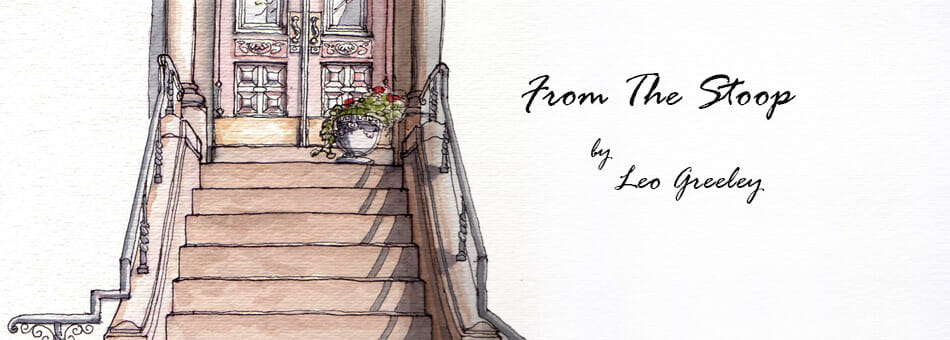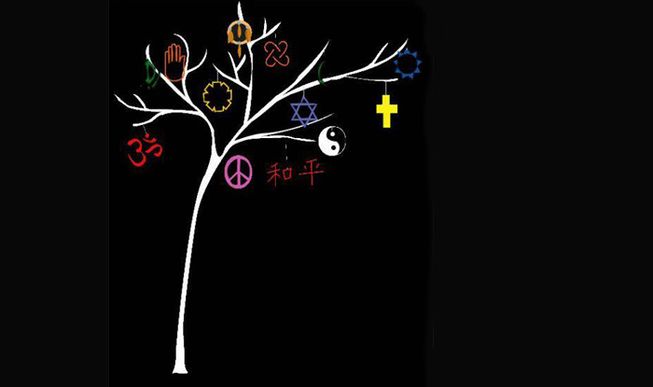From the Stoop Dec 2017

Sometimes the stoop needs a little bit of distancing and the quiet your favourite chair provides. My window provides the view I normally have but a fresh coat of snow and the glimmer of lights in my neighbour’s trees precludes my sitting outside.
Christmas themed movies dominate television and Christmas themed music is everywhere. Black Friday sales have started and it is only a Tuesday. The countdown to Christmas is a constant reminder that we should be out spending at least the national average of $983 per person. The theology of a Christian celebration is the driving factor behind everything mainstream Holiday Season and very few, in comparison, actually celebrate the true meaning of Christmas. Our material society has taken over a simple birthday celebration and it looks like there is no return.
Christianity and the birthday of Christ is a relative newcomer to world religions yet it is the most influential in world politics, wealth and law. There is a myriad of other religions both new and old that quietly celebrate and worship without really being noticed and for some reason not targeted by retailers.
I celebrate Christmas day with my family even if I don’t believe in the Christian version of God and heaven. I celebrate my “Christmas” at Yule during the Winter Solstice and reflect then of the year past, celebrate the rebirth of the Sun and I plan for the future. Often during this time of year, I wonder what other religions celebrate while at the same time taking advantage of Christmas and the Santa lore.
Would our acceptance of others change if we saw the commonalities of others instead of differences? It requires that no one has the right to claim that their God is the only one and that all others are false gods. All religions are basically built on a common set of principles and it is only the traditions and the messenger that differ.
If you follow your path and believe firmly in your messenger’s teachings then no fault should come to you. At the same time, how can you fault others if you respect others choices? I realize this is simplistic but I am optimistic that the Bible, Qur’an, Shuti, Tripitaki, Dao de jing, Tanakh and the Wiccan Crede (among others) all support love and understanding. I firmly believe that at least understanding the principles of other peoples beliefs gives you both a common ground and a strengthening of your own faith.
In celebration of the season search out someone who is not of your faith and exchange the gift of knowledge. Try to accept their beliefs and hope they accept yours.
You may find we are not that different it seems. I know I am missing so many celebrations, and there are some I do not understand their regionalism, so I have left them out. I, for one, would love to hear your traditions, stories and especially those who are far from their birth home I would be interested in hearing how you celebrate here in Ottawa.
These are some of the December celebrations. So many others occur throughout the year and they too are associated with the birth of a religion or milestones. If I lack accuracy or inclusion please forgive and correct me.
Dec. 5, Ashura, the 10th day of the first month of the Islamic calendar. Sunnis, the largest group of Muslims, remember that the Prophet Muhammad fasted in solidarity with Jews who were observing Yom Kippur, the Day of Atonement. Shiites recall the death of Muhammad’s grandson in battle, an event that led to their differences with the Sunnis.
Dec. 8, Bodhi Day. Buddhists recall that Siddhartha Gautama vowed to sit under a tree in what is now Bodhgaya, India, and not to rise until he was enlightened. The title Buddha means “awakened one.”

Dec. 20, the Jewish festival of Hanukkah begins at sunset on this date and continues for seven more nights. It is a remembrance of an effort to restore the Temple in Jerusalem after a period of desecration. Faithful Jews found only enough oil to light the temple lamp for one day, but the flame burned for eight.
Dec. 22, Yule or winter solstice, the shortest day in the Northern Hemisphere. Juul, a pre-Christian festival observed in Scandinavia, featured fires lit to symbolize the heat, light and life-giving properties of the returning sun. Wiccans and other pagan groups celebrate Yule.
Dec. 25, Christmas, observed by Christians since the Middle Ages as the birth of Jesus. Some Orthodox Christians follow a different calendar, and Christmas may fall on a different date.
Dec. 26, Zoroastrians observe the death of the prophet Zarathustra, known in the West as Zoroaster. Tradition says he lived in what is now Iran in about 1200 B.C. His teachings include the idea of one eternal God; seven powerful creations: sky, water, earth, plants, animals, humans and fire; and that life is a struggle between good and evil.
Dec. 26, This is also the starting date for Kwanzaa, a weeklong, modern African-American and pan-African celebration of family, community and culture. For some people who keep Kwanzaa, the festival has spiritual overtones in its emphasis on imani, Swahili for “faith.”
My celebration.
Yule, (pronounced EWE-elle) is when the dark half of the year relinquishes to the light half. Starting the next morning at sunrise, the sun climbs just a little higher and stays a little longer in the sky each day. Known as Solstice Night, or the longest night of the year, the sun’s “rebirth” was celebrated with much joy. On this night, our ancestors celebrated the rebirth of the Oak King, the Sun King, the Giver of Life that warmed the frozen Earth. From this day forward, the days would become longer.
Bonfires were lit in the fields, and crops and trees were “wassailed” with toasts of spiced cider. Children were escorted from house to house with gifts of clove spiked apples and oranges which were laid in baskets of evergreen boughs and wheat stalks dusted with flour. The apples and oranges represented the sun. The boughs were symbolic of immortality (evergreens were sacred to the Celts because they did not “die” thereby representing the eternal aspect of the Divine). The wheat stalks portrayed the harvest, and the flour was an accomplishment of triumph, light, and life.
Holly and ivy not only decorated the outside but also the inside of homes, in hopes Nature Sprites would come and join the celebration. A sprig of Holly was kept near the door all year long as a constant invitation for good fortune to visit the residents. Mistletoe was also hung as decoration. It represented the seed of the Divine, and at Midwinter, the Druids would travel deep into the forest to harvest it.
From my family to yours, Blessed Yule, Merry Christmas and all the best during this special season.